We Have Come To Take You Home (A Diana Ferrus Tribute), 2018. (Lady Skollie)
The Bible says that when Moses led the Israelites out of Egypt and into the land of milk and honey, he had been told to do so by the Lord, who appeared to him in a burning bush.
“Moses is important to me because of that burning bush,” says artist Lady Skollie as she eases a walkabout crowd into her latest solo show, Good & Evil. “I want this show to be a burning bush to you all,” she continues as she stands before the 15 artworks that make up her exhibition.
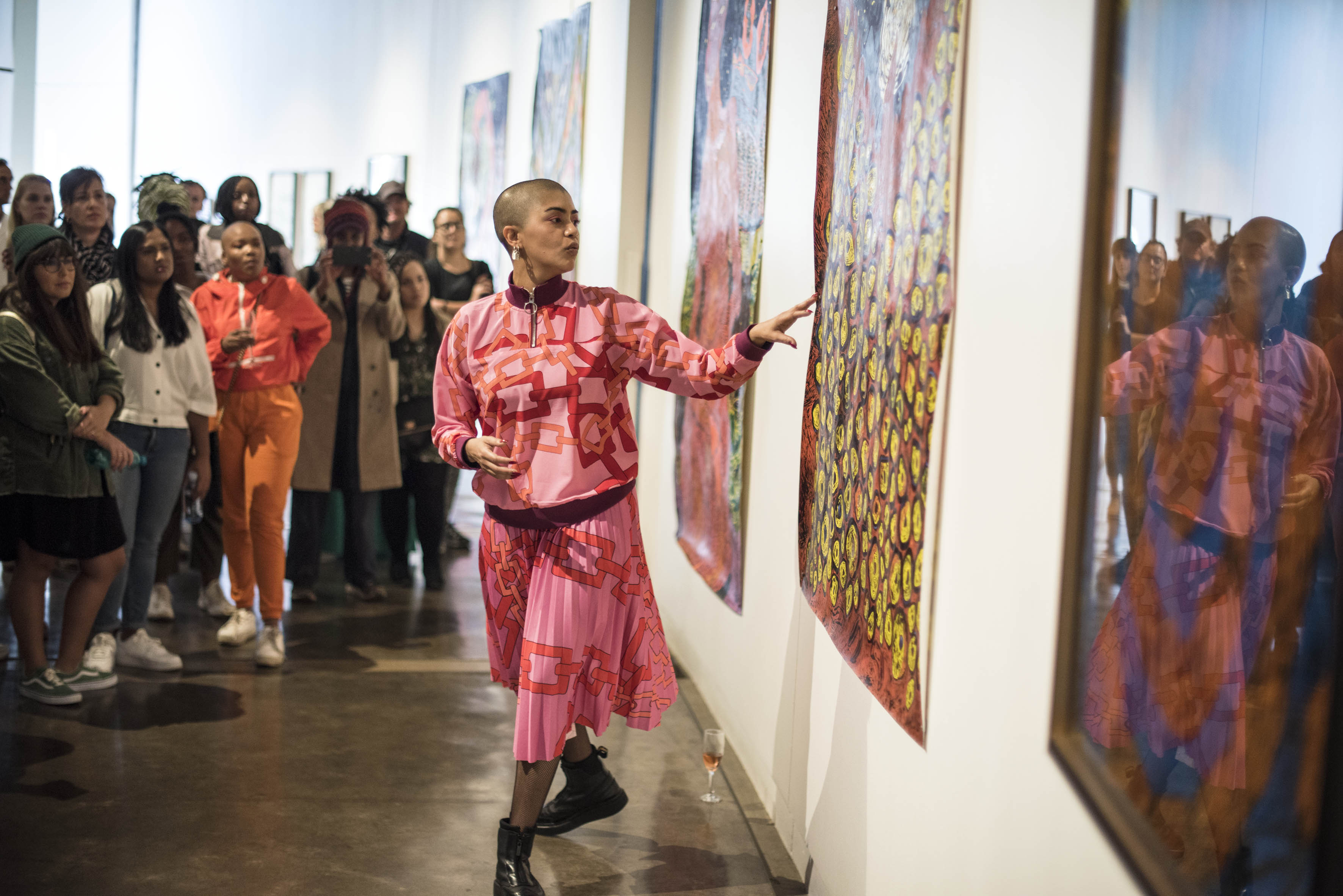
Observations: Lady Skollie giving a walkabout at Circa gallery, the site of her new exhibition Good & Evil. (Paul Botes/ M&G)
Good & Evil reimagines the history of people of “so-called coloured descent”, one in which they’re led to a promised land free of ignorance and self-hatred. The artist believes there is a need for this because their heritage was “nipped in the bud”.
Prior to trying her hand at fine art, Lady Skollie, aka Laura Windvogel, had already begun indulging in her artistry three times a week, for nine years, at the Joubert Art Centre (now called the Peter Clarke Art Centre).
After two years at the University of Cape Town’s (UCT’s) Michaelis School of Fine Art, she changed majors and graduated in 2009 with a BA in art history and Dutch literature. In 2014, she got a certificate in business acumen for artists from UCT’s Graduate School of Business in 2014. Through this combination of knowledge the artist has managed to stay in the game with a strong sense of agency.
Since graduating, Lady Skollie has had nine solo shows, held at Cape Town’s Association for Visual Arts Gallery and Worldart Gallery, the Stevenson galleries in Cape Town and Johannesburg, the TMRW Gallery and Everard Read in Johannesburg, and Tyburn Gallery in London.
She deviated from her classical art training when she started establishing herself as an artist. Instead of being represented by a gallery, Lady Skollie made use of social media — starting with Tumblr and then Instagram — to promote her work.
“At the moment I am represented by Everard Read gallery in the United Kingdom, Johannesburg and Cape Town. Galleries are like boyfriends, if you catch my drift,” she says. “The role of the gallery is going through a massive shift. We do not exist for the white cube. So social media has been a massive pro for me. It’s why I can remain independent, because I am my own voice. It doesn’t make sense for me if I have to ask someone if it’s okay for me to do something.”
With the addition of publishing the sex-confessions zine, Kaapstad Kinsey, hosting sex parties, broadcasting podcasts and maintaining a strong social media presence, Lady Skollie’s work goes beyond artistic commentary on sex, politics and racial identity as a coloured womxn in post-apartheid South Africa. Instead, her multimodal body of work reaches into uncomfortable realms, so that it is a site of protest and a means of education.
Banele Khoza, fine artist and owner of the open studio and gallery space BKhz, says: “I enjoy the courage that Laura has to be fully visible and heard at all times. Her opinions and experiences are always heard, which not many have the courage to bring forward. Her art is equally the same — bold and courageous. We need more artists like her who can stand up for themselves.”
Sipping on naked truth
Through themes of objectification, sexual identity, gluttony, self-deprivation, alcoholism, colonialism and racial identity, Good & Evil challenges multiple binaries and enlightens audiences about the nuances of coloured identity.
The totality of this layered offering is seen through one of the exhibition’s larger paintings, Papsak Propaganda: When I was five my school took us to the farm of a white man and we stamped on grapes for hours. It was delightful, but I’m sure we were free labourers of chardo-naai, chardonnay, chenin-black-out (2019).
The piece, on a 100cm x 70cm Fabriano canvas, depicts two women with orange tiger-like skin and faces covered in gold leaf, wearing nothing but Voortrekker kappies. As they stomp grapes in a barrel, the blindfolded figures embrace one another before a yoni-shaped golden portal.
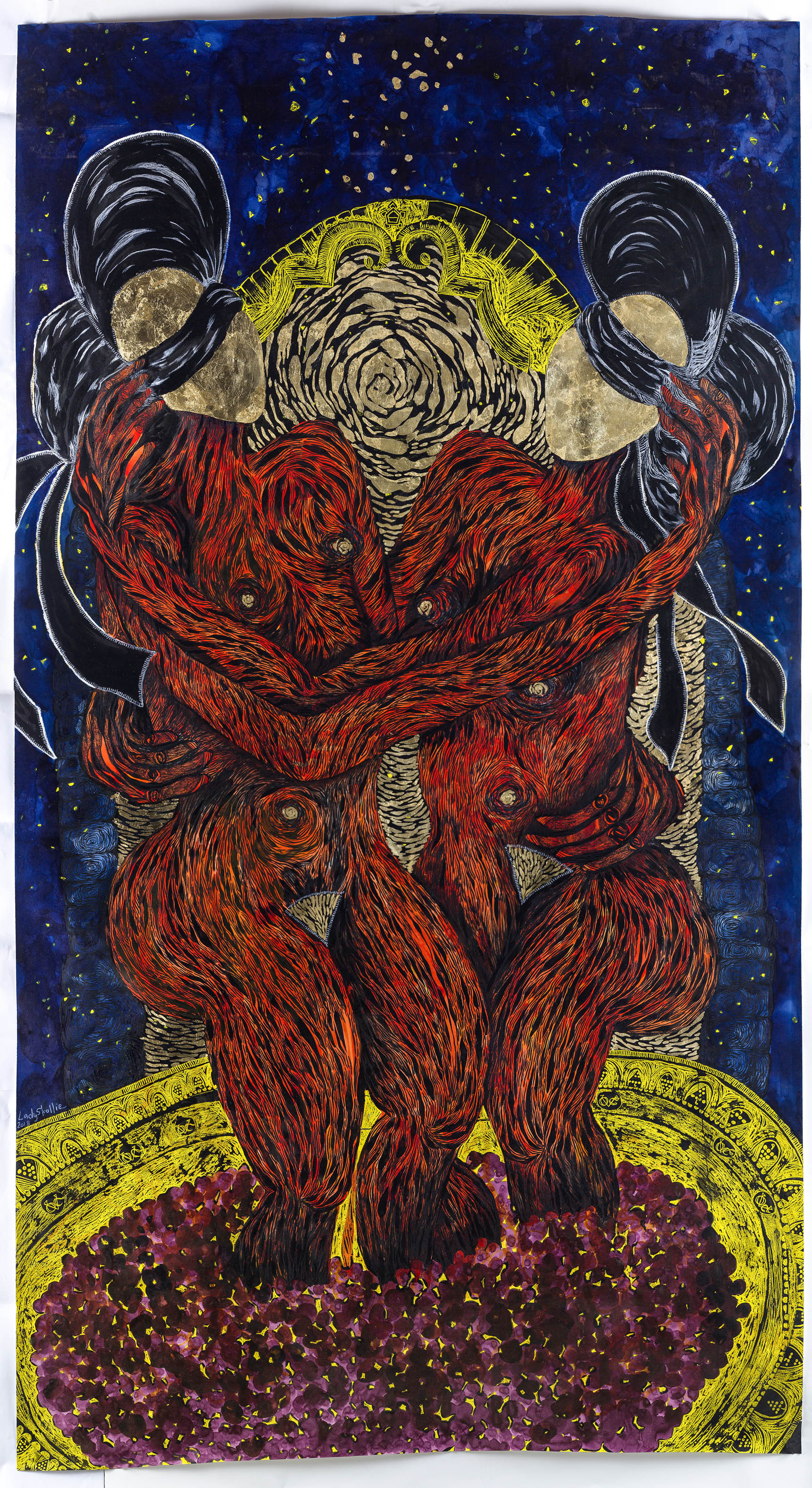
Papsak Propaganda: When I was five my school took us to the farm of a white man and we stamped on grapes for hours. It was delightful, but I’m sure we were free labourers of chardo-naai, chardonnay, chenin-black-out (2019).
Lady Skollie explains how the image was a reference to an endearing childhood memory that has since become a source of disdain. “At the time, it seemed fun. But now I realise that it was unpaid labour, because we were making wine,” she scoffs.
In addition to highlighting the history of cheap labour and the dop system (or papsak payment) on wine farms, the piece celebrates her heritage as a descendent of the San by referencing a dance used to awaken the ancestors. The riel dance, which predates colonialism, sees dancers moving through a sequence of fast-paced footwork that causes dust to rise. It was able to continue under colonial rule only because the dancers wore colonial garb, including the Voortrekker kappie.
To further commentary about the relationship between alcoholism and colonialism, which Lady Skollie calls papsak propaganda, the artwork is placed next to one called Bottle Feeding: Like the classic image of the champagne flute tower, pouring into the top, trickling to the bottom. Papsak propaganda II (2018).
On a blue crayon backdrop depicting the sea, the 100cm x 70cm drawing portrays a large human shadow with a collar of bananas standing above an uneasy crowd of people with tiger-striped faces, who he pacifies by pouring liquid out of green bottles that mimic the size and silhouette of a Castle Lite ngud (quart) or a 750ml bottle of wine.
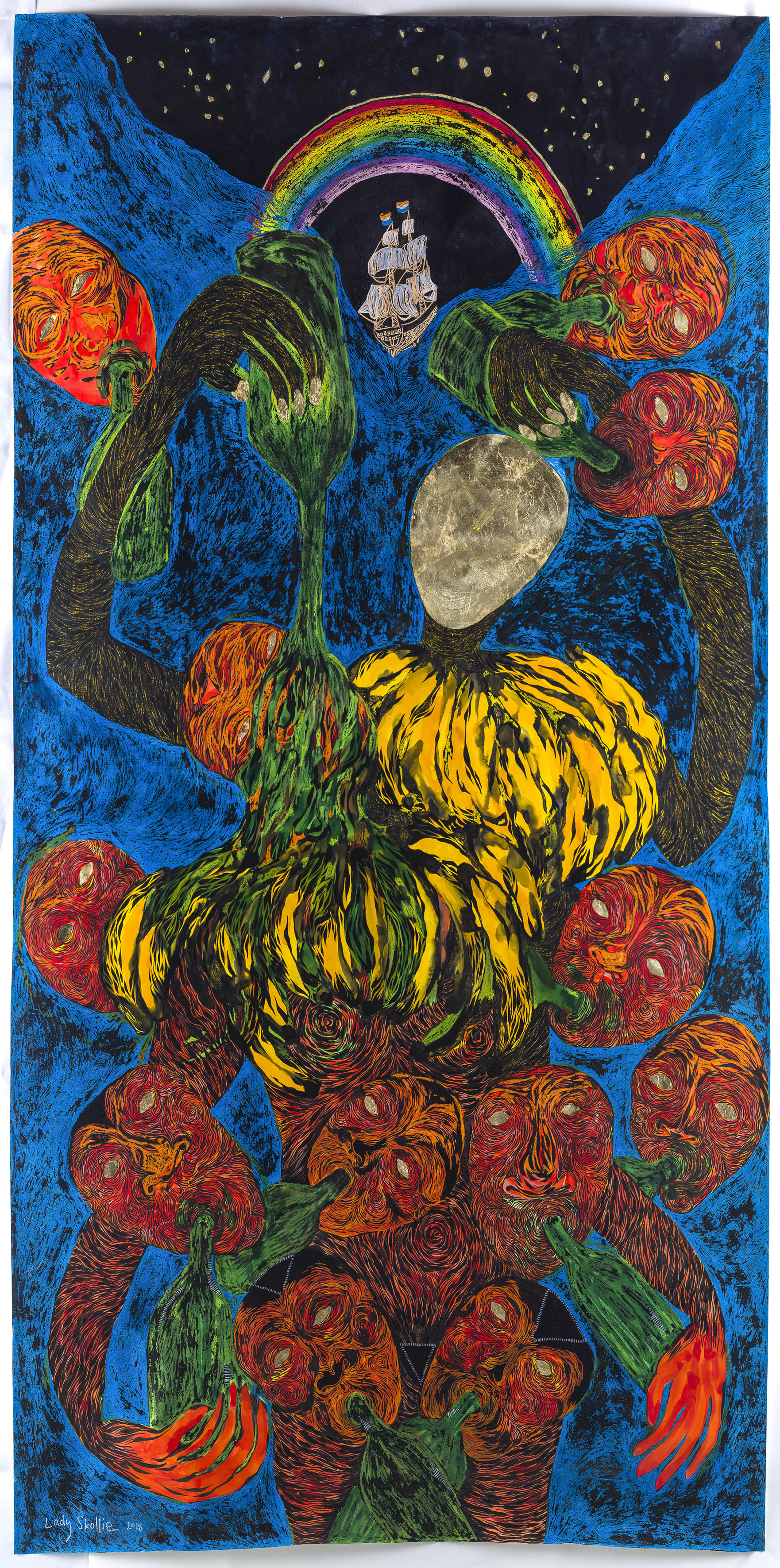
Bottle Feeding: Like the classic image of the champagne flute tower, pouring into the top, trickling to the bottom. Papsak propaganda II (2018)
“These two works … are what previous galleries said were the darkest, ugliest works they had ever seen and they would never sell,” Lady Skollie says. “They said I shouldn’t talk about liquor being used to control people of colour, because it’s such a South African thing to talk about. And it’s not. Alcohol has always been used as a tool for making people forget where they came from, what they are, who they are and what they could do.”
This conviction is also seen in Papsak Propaganda III: And I was really far out and you thought I was waving, but I was drowning (Stevie Smith Tribute) (2018), where the character drowns in empty green bottles of wine.
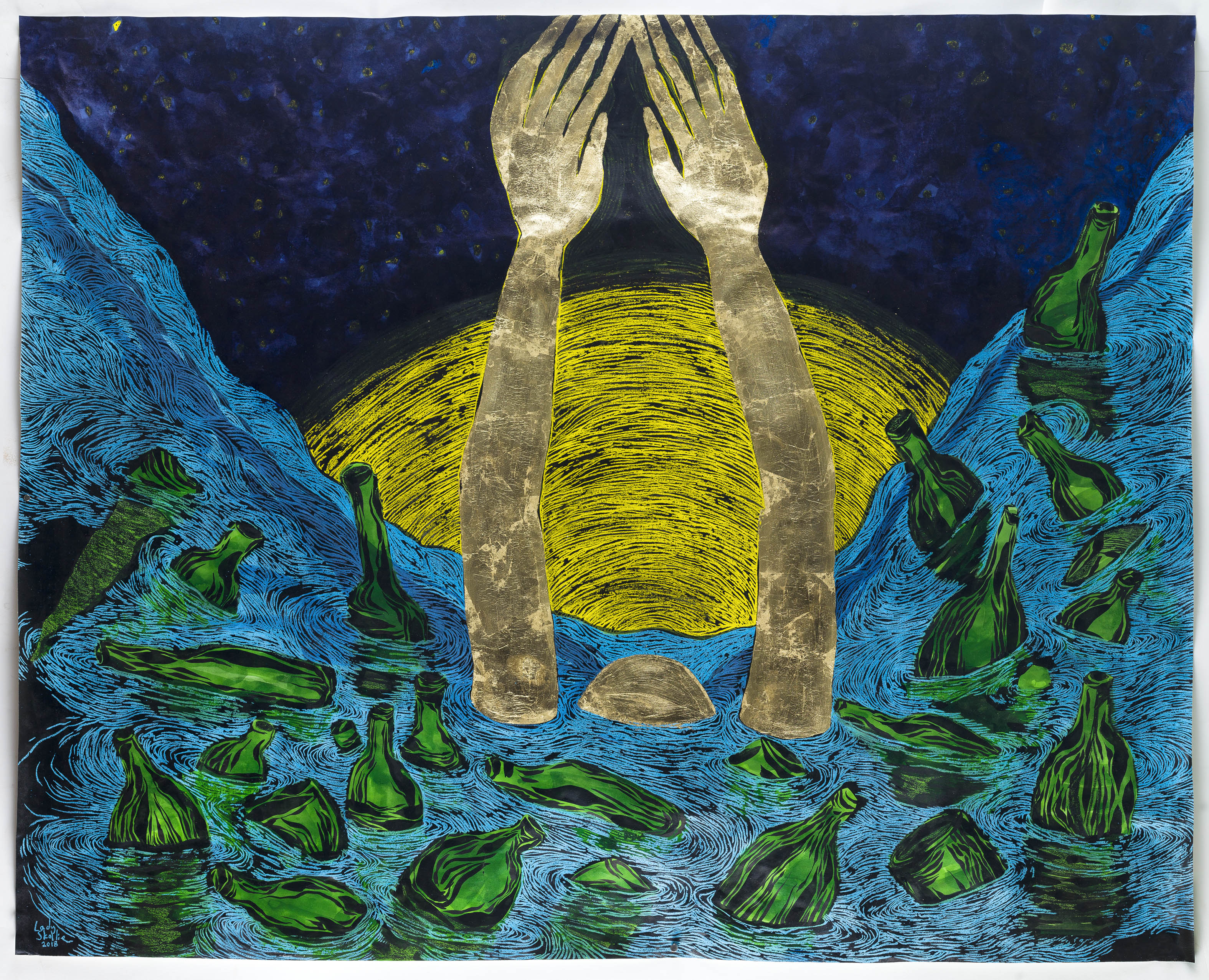
Papsak Propaganda III: And I was really far out and you thought I was waving, but I was drowning (Stevie Smith Tribute) (2018)
Themes about sex in contemporary South Africa — such as sexual identity and fluidity, violence, greed, lust and ownership — are mostly tackled through the artist’s figurations. The depiction of vaginas, penises, breasts and derrieres as well as phallic and yonic-like fruits such as large bananas and ripe papayas is predominant, daring the audience into categorising Lady Skollie’s work as erotic, though the figures do not perform acts.
This is furthered by the artist’s exaggeration of nudity through giving some of her characters six breasts, making snake figurations from “a linocut of pussies” and covering the nude bodies of the womxn in what looks like tiger stripes to represent the dehumanisation that comes with fetishising black womxn’s bodies. This exaggeration and fetishising is depicted in works such as Eat the Fruit by Yourself, All of it, Feel the Snake Slither (2018), Share, Cut the Fruit in Half, Watch it Rot (2019) and Cagn Speaking to the People From the Sky (2018).
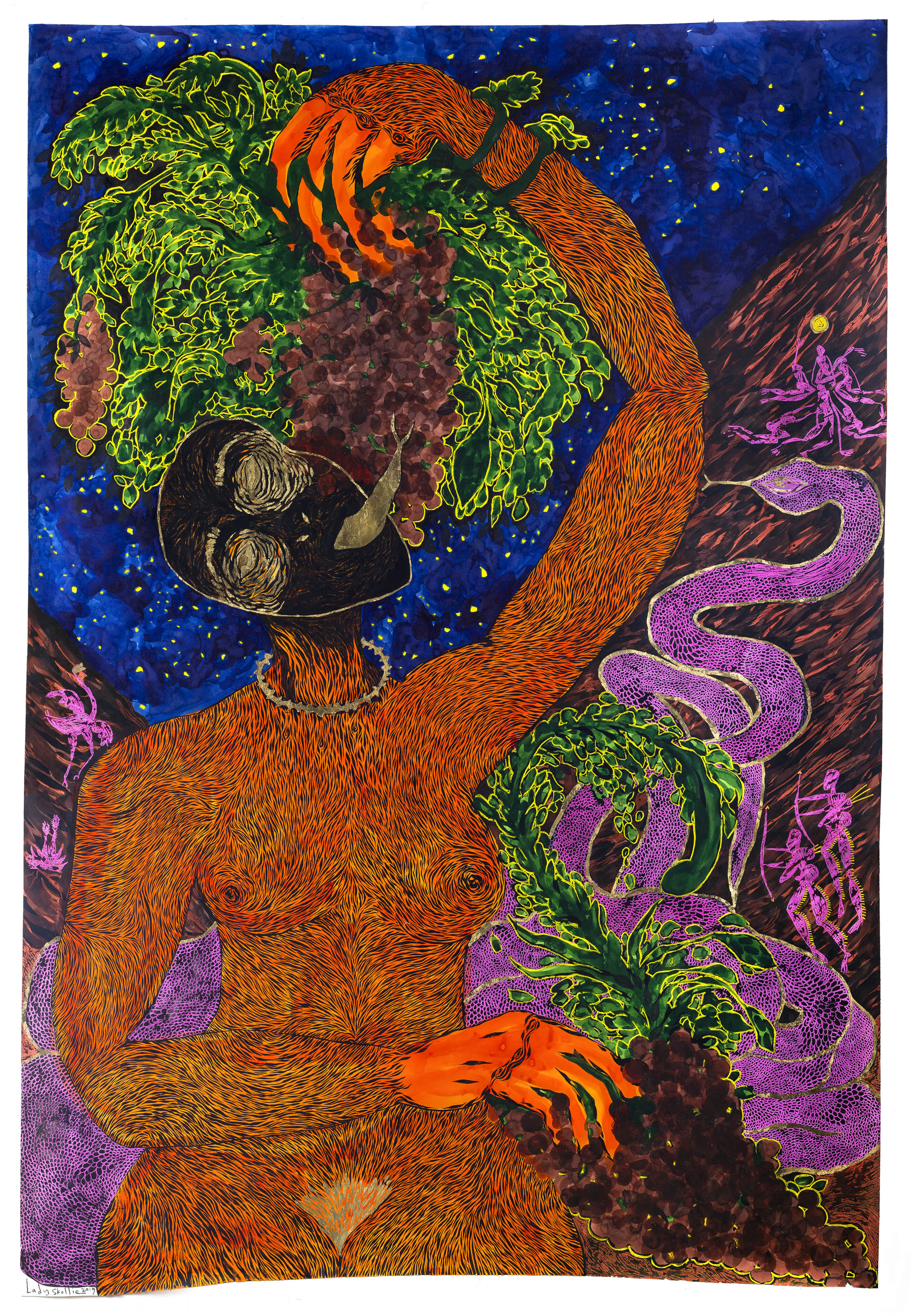
Eat the Fruit by Yourself, All of it, Feel the Snake Slither (2018)
Upon interrogating these works with Lady Skollie, and placing them in the broader context of her entire body of work, their meaning moves from symbols of sex into cliteracy territory. In this context, cliteracy refers to an awareness of the naked body in a way that goes beyond its place in sexual pleasures. By having nude figures depicted in everyday acts such as eating, being in prayer and dancing, her work challenges people to look at the naked figurations as deserving of agency, consent and freedom from unwanted and violently unrelenting lust.
In 2016, Lady Skollie was commissioned to design the cover of Abafazi, a supplement for Women’s Month for the Mail & Guardian. The art piece, titled Cut-cut, Kill-kill, Stab-stab: A South African Love Story (2016), was accompanied by an essay in which the artist wrote: “I am angry about a lot of things. Mostly pertaining to existing on this planet as a womxn. My anger takes many forms, usually in online tirades, sometimes in scathing comments wrapped in humour, sometimes in garish watercolour drawings of genitals. I don’t know how to translate all of this anger into action; I’m trying to focus my energy into making the world a better place for womxn.”
Other figurations in her work, especially the animals, are the artist’s response to religious tropes such as Eve from the book of Genesis and Cagn (lKággen), the San deity who can take different forms such as a praying mantis, an eland and a snake.
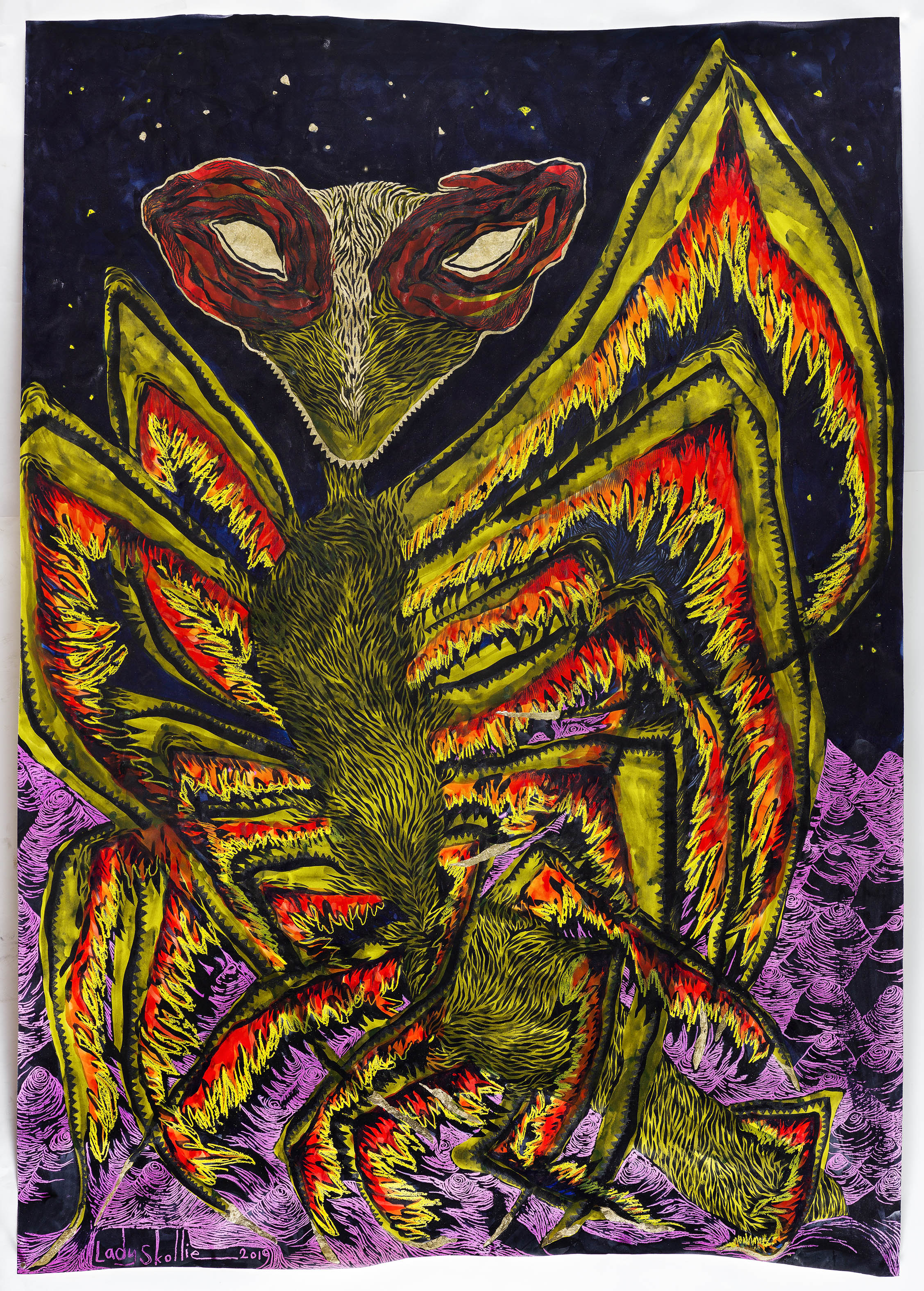
Cagn as a flaming praying mantis (2019)
Lady Skollie reproduces her consistent set of figurations on the two coins she designed for the South African Mint to commemorate 25 years of democracy. In addition to a new R5 coin, Lady Skollie designed the sterling silver collectable R50 coin (which costs R900 to buy). During the design process, artists were asked not to represent people in terms of race, religion or creed.
“I went big because my art uncle, Athi-Patra Ruga, told me to. And also because I want my drawings to represent giant pop culture cave drawings, a representation of what could have been if we were not eradicated into the earth,” Lady Skollie says.
Finally allowed to tell you: I designed the new R5 coin for South Africa. This one is for my people. Also think of me when you spend this. I love you South Africa #SA25 @SAMintpic.twitter.com/yz1ReilsxN
— Lady Skollie (@LadySkollie) June 5, 2019
Her design, which appears on both coins, recalls the indelible photographs of South Africans standing in long, helical queues waiting to vote in the first South African national democratic elections. But Lady Skollie’s design has rock art-like figures in a helical line leading to the ballot box.
Referencing materials
What makes Lady Skollie’s artistic commentary on difficult conversations approachable is her use of humour through exaggeration, the life-size scale of most of her work and the intricate patterns and vibrant colours. She works in ink, watercolours, crayons and gold leaf on Fabriano paper. What results from the medley of materials is art that delivers a lasting bite after seducing its audience through its surface-level appeal.
Although they are not salient, the academic influences in Lady Skollie’s work are evident in her constant referencing of literature, some of which she includes in the Good & Evil walkabout. The pile of books, placed on a leather bench in the centre of the gallery, include Fiela se Kind by Dalene Matthee, Kanna Hy Kô Hystoe by Adam Small and The Cape Malay Cookbook by Faldela Williams.
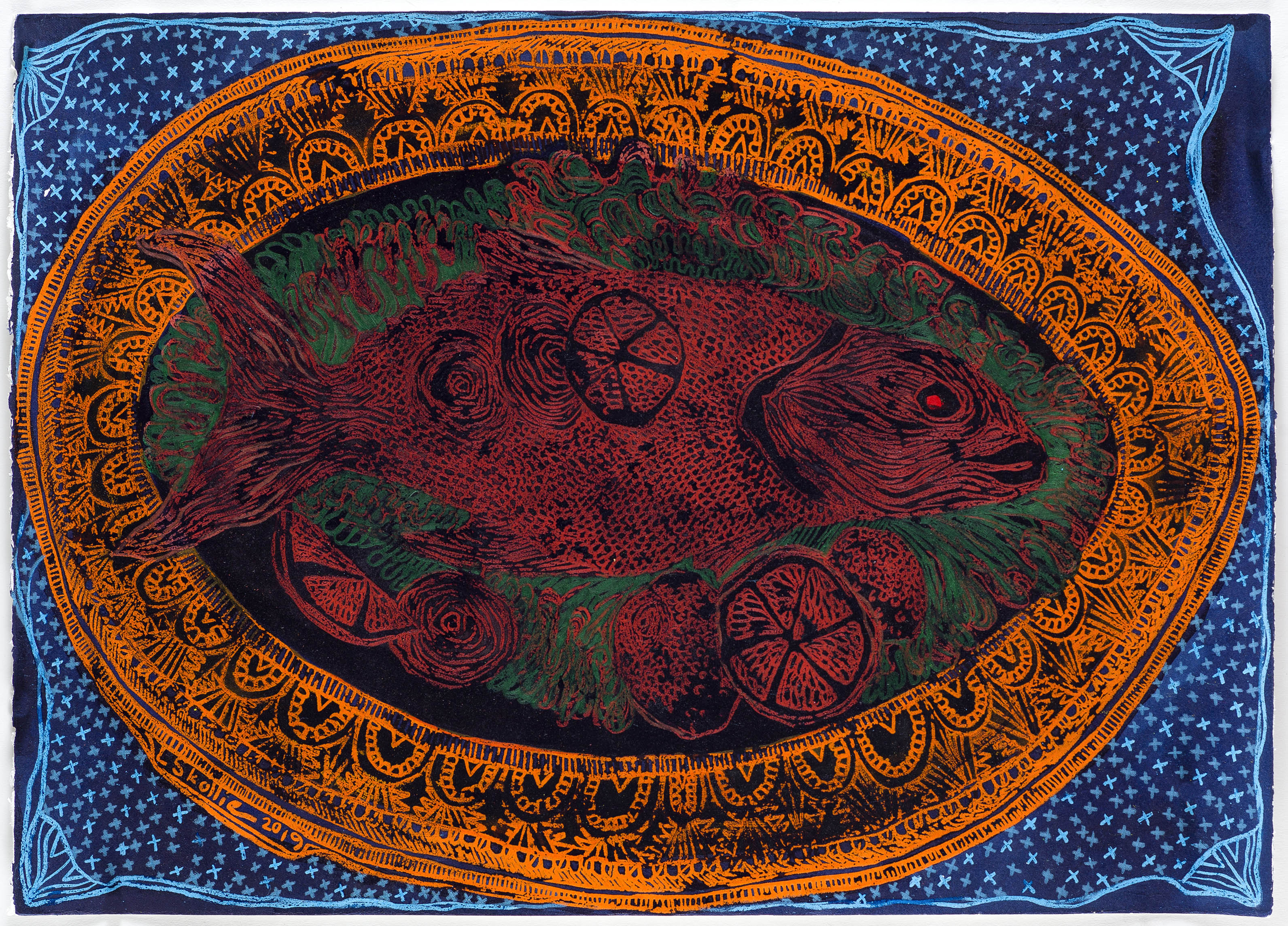
Books, such as The Cape Malay Cookbook, have inspired Lady Skollie’s art. The Cape Malay Cookbook (2019)
Toward the end of the walkabout Lady Skollie explains how she used these books in her works.
Fiela se Kind is the story of a coloured woman finding a white child abandoned on her doorstep. She raises him for nine years before government census officials remove him, believing him to be the son of a white family of woodcutters in the Knysna forest. The book provided a way to explore liminality in coloured people’s identity. Kanna Hy Kô Hystoe unpacks issues of displacement and voluntary exile, the violence of forced removals and coloured peoples identity in District Six. The photographs, recipes and stories of their origins in the cookbook represent “what it means to fundamentally be coloured in a lot of ways”, says Lady Skollie.
Other texts that she cites as influences include the Children’s Bible and artist and academic Pippa Skotnes’s book, Unconquerable Spirit: George Stow’s History Paintings of the San.
After discussing the literary influences, Lady Skollie admits to being wary of relying on them, particularly books written by white people about San knowledge systems.
“The San elements that I am inspired by are not complete, and unfortunately, due to colonisation, I will never know the extent of knowledge, culture and true power the San people possessed,” she explains.
Deliverance
Throughout Good & Evil’s reimagining and attempt at deliverance of people of “so-called coloured descent”, the artwork Lady Skollie holds in the highest and most dear regard is ’n Skaans Teen die Donker (Protection Against the Dark): I collect them all together under my arms, lifting us all up together, up and away from the past (2019). Here the supreme being lKággen stands in the centre, enclosing people under a cape that shields them from a flock of ostriches.
“The ostrich symbolises financial freedom for coloured people. Back in the day in Europe when the plume was making its rounds, everyone loved it and they bred those ostriches here,” Lady Skollie explains, before alluding to the trap that came with farming ostriches in the same way working on vineyards did. The act of separating people from the ostriches then becomes symbolic of the need for financial freedom to attain the independence Lady Skollie has and clings on to as she navigates her way through the art world.
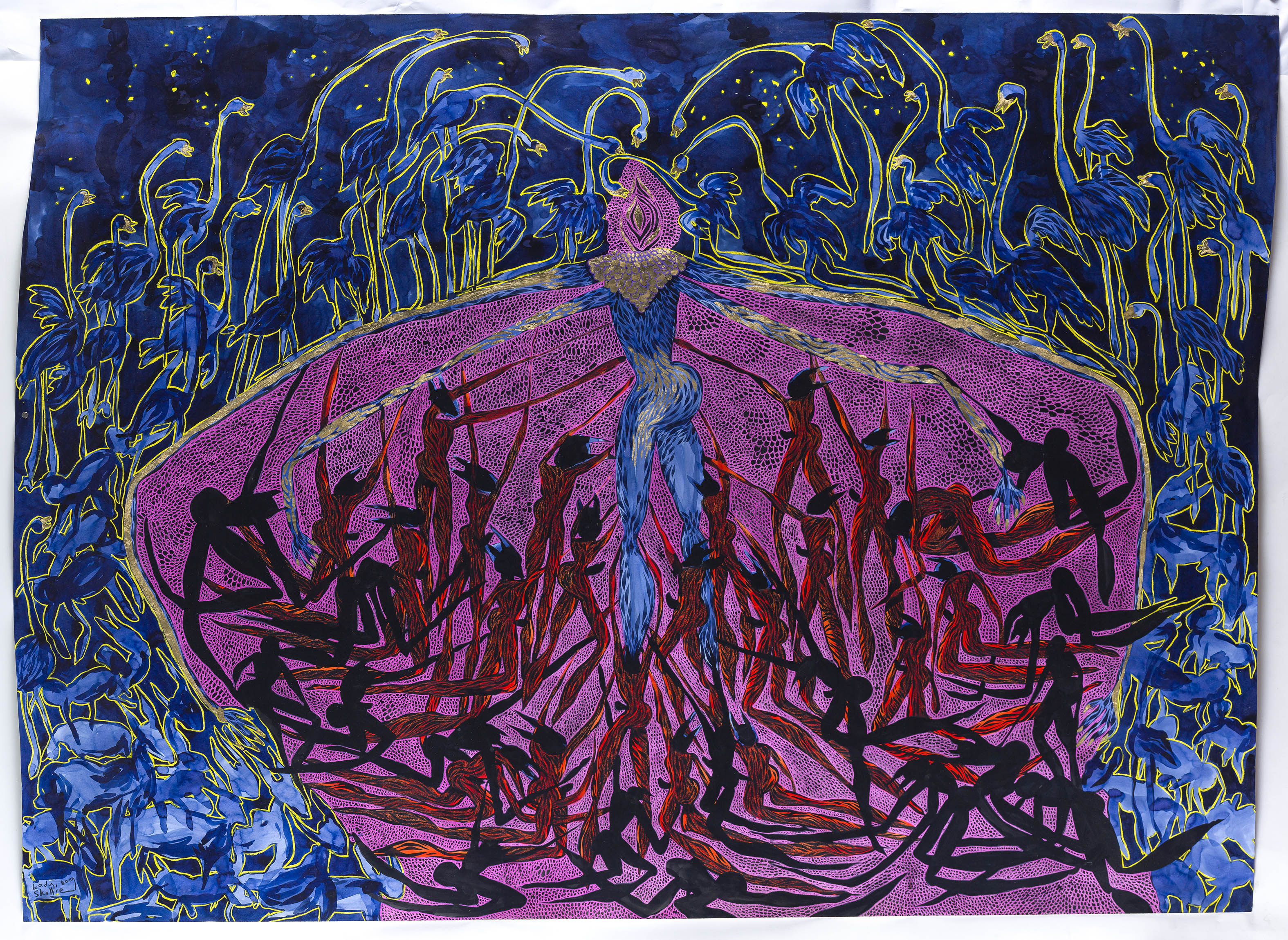
’n Skaans Teen die Donker (Protection Against the Dark): I collect them all together under my arms, lifting us all up together, up and away from the past (2019)
In an Instagram post leading up to the opening of Good & Evil, Lady Skollie reflected on the times she experienced before she had her financial comfort: “Thank u god for the fact that I have a studio, that I’m an artist who can say I pay for it all with art… Yassis, sometimes I think back on those days I used to work at a counter in Long Street, saving up for fabriano, scamming people for studio rent … working in a shop in the day, at a bar at night, hardly painting, working in a gallery installing other people’s boring kak art. Thank u god for all this and god u know this isn’t even the final form. [Ek] gaan hulle naar maak.”